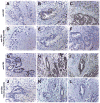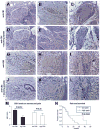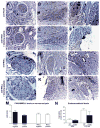Cannabinoids in pancreatic cancer: correlation with survival and pain
- PMID: 17943729
- PMCID: PMC2225529
- DOI: 10.1002/ijc.23114
Cannabinoids in pancreatic cancer: correlation with survival and pain
Abstract
Cannabinoids exert antiproliferative properties in a variety of malignant tumors, including pancreatic ductal adenocarcinoma (PDAC). In our study, we quantitatively evaluated the immunoreactivity for cannabinoid-1 (CB1) and cannabinoid-2 (CB2) receptors as well as for the endocannabinoid metabolizing enzymes fatty acid amide hydrolase (FAAH) and monoacyl glycerol lipase (MGLL). Furthermore, quantitative real-time RT-PCR for CB1, CB2, FAAH and MGLL in normal pancreas and pancreatic cancer tissues was performed. Levels of endocannabinoids were determined by liquid chromatography/mass spectrometry. Immunoreactivity scores and QRT-PCR expression levels were correlated with the clinico-pathological (TNM, survival, pain) status of the patients. Evaluation of endocannabinoid levels revealed that these remained unchanged in PDAC compared to the normal pancreas. Patients with high CB1 receptor levels in enlarged nerves in PDAC had a lower combined pain score (intensity, frequency, duration; p = 0.012). There was a significant relationship between low CB1 receptor immunoreactivity or mRNA expression levels (p = 0.0011 and p = 0.026, respectively), or high FAAH and MGLL cancer cell immunoreactivity (p = 0.036 and p = 0.017, respectively) and longer survival of PDAC patients. These results are underlined by a significant correlation of high pain scores and increased survival (p = 0.0343). CB2 receptor immunoreactivity, CB2 receptor, FAAH and MGLL mRNA expression levels did not correlate with survival. Therefore, changes in the levels of endocannabinoid metabolizing enzymes and cannabinoid receptors on pancreatic cancer cells may affect prognosis and pain status of PDAC patients.
(c) 2007 Wiley-Liss, Inc.
Figures






Similar articles
-
Dynamics of expression and localization of the cannabinoid system in granulosa cells during oocyte nuclear maturation.Fertil Steril. 2015 Sep;104(3):753-60. doi: 10.1016/j.fertnstert.2015.06.013. Epub 2015 Jul 3. Fertil Steril. 2015. PMID: 26144572
-
Alterations in endocannabinoid tone following chemotherapy-induced peripheral neuropathy: effects of endocannabinoid deactivation inhibitors targeting fatty-acid amide hydrolase and monoacylglycerol lipase in comparison to reference analgesics following cisplatin treatment.Pharmacol Res. 2013 Jan;67(1):94-109. doi: 10.1016/j.phrs.2012.10.013. Epub 2012 Nov 2. Pharmacol Res. 2013. PMID: 23127915 Free PMC article.
-
Endocannabinoid dysregulation in the pancreas and adipose tissue of mice fed with a high-fat diet.Obesity (Silver Spring). 2008 Mar;16(3):553-65. doi: 10.1038/oby.2007.106. Epub 2008 Jan 17. Obesity (Silver Spring). 2008. PMID: 18239598
-
Medicinal chemistry of cannabinoids.Clin Pharmacol Ther. 2015 Jun;97(6):553-8. doi: 10.1002/cpt.115. Epub 2015 Apr 16. Clin Pharmacol Ther. 2015. PMID: 25801236 Free PMC article. Review.
-
Pharmacotherapeutic modulation of the endocannabinoid signalling system in psychiatric disorders: drug-discovery strategies.Int Rev Psychiatry. 2009 Apr;21(2):122-33. doi: 10.1080/09540260902782778. Int Rev Psychiatry. 2009. PMID: 19367506 Free PMC article. Review.
Cited by
-
The endocannabinoid system, cannabinoids, and pain.Rambam Maimonides Med J. 2013 Oct 29;4(4):e0022. doi: 10.5041/RMMJ.10129. eCollection 2013. Rambam Maimonides Med J. 2013. PMID: 24228165 Free PMC article.
-
Cannabinoids for neuropathic pain.Curr Pain Headache Rep. 2014 Oct;18(10):451. doi: 10.1007/s11916-014-0451-2. Curr Pain Headache Rep. 2014. PMID: 25160710 Review.
-
Development of a prognostic model for early-stage gastric cancer-related DNA methylation-driven genes and analysis of immune landscape.Front Mol Biosci. 2024 Oct 30;11:1455890. doi: 10.3389/fmolb.2024.1455890. eCollection 2024. Front Mol Biosci. 2024. PMID: 39575189 Free PMC article.
-
A comprehensive review on phytochemicals in the treatment and prevention of pancreatic cancer: Focusing on their mechanism of action.Health Sci Rep. 2024 Apr 29;7(5):e2085. doi: 10.1002/hsr2.2085. eCollection 2024 May. Health Sci Rep. 2024. PMID: 38690008 Free PMC article.
-
Cannabinoids reduce markers of inflammation and fibrosis in pancreatic stellate cells.PLoS One. 2008 Feb 27;3(2):e1701. doi: 10.1371/journal.pone.0001701. PLoS One. 2008. PMID: 18301776 Free PMC article.
References
-
- Kleeff J, Michalski C, Friess H, Buchler MW. Pancreatic cancer: from bench to 5-year survival. Pancreas. 2006;33:111–8. - PubMed
-
- Jemal A, Siegel R, Ward E, Murray T, Xu J, Smigal C, Thun MJ. Cancer statistics, 2006. CA Cancer J Clin. 2006;56:106–30. - PubMed
-
- Sener SF, Fremgen A, Menck HR, Winchester DP. Pancreatic cancer: a report of treatment and survival trends for 100,313 patients diagnosed from 1985–1995, using the National Cancer Database. J Am Coll Surg. 1999;189:1–7. - PubMed
-
- Eckel F, Schneider G, Schmid RM. Pancreatic cancer: a review of recent advances. Expert Opin Investig Drugs. 2006;15:1395–410. - PubMed
-
- Di Marzo V, Bifulco M, De Petrocellis L. The endocannabinoid system and its therapeutic exploitation. Nat Rev Drug Discov. 2004;3:771–84. - PubMed
Publication types
MeSH terms
Substances
Grants and funding
LinkOut - more resources
Full Text Sources
Other Literature Sources
Medical

